Practice Free AZ-104 Exam Online Questions
HOTSPOT
You have an Azure subscription.
You need to use an Azure Resource Manager (ARM) template to create a virtual machine that will have multiple data disks.
How should you complete the template? To answer, select the appropriate options in the answer area. NOTE: Each correct selection is worth one point.
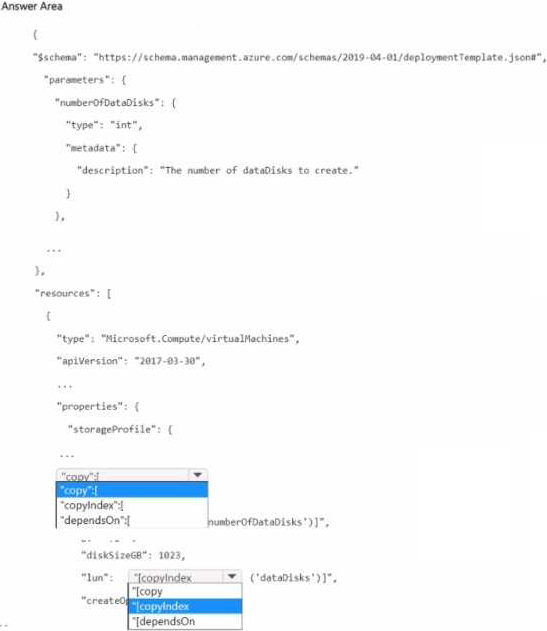

You have an Azure virtual machine named VM1 that runs Windows Server 2019.
You save VM1 as a template named Template1 to the Azure Resource Manager library.
You plan to deploy a virtual machine named VM2 from Template1.
What can you configure during the deployment of VM2?
- A . virtual machine size
- B . operating system
- C . administrator username
- D . resource group
D
Explanation:
Resource Group is the correct answer: Admin user, password, vm size and os are the part of ARM templates. But resource group is not hence needs to be mentioned while deployment! Refer below sample ARM template for reference in which all above attributes passed in parameter. https://github.com/Azure/azure-quickstart-templates/blob/master/101-vm-simple-windows/azuredeploy.json
You have an Azure subscription.
You plan to deploy the Azure container instances shown in the following table.

Which instances can you deploy to a container group?
- A . Instance1 only
- B . Instance2only
- C . Instance1 and lnstance2 only
- D . Instance3 and Instance4 only
C
Explanation:
https://learn.microsoft.com/en-us/azure/container-instances/container-instances-container-groups Multi-container groups currently support only Linux containers. For Windows containers, Azure Container Instances only supports deployment of a single container instance. While we are working to bring all features to Windows containers, you can find current platform differences in the service
Note: This question is part of a series of questions that present the same scenario. Each question in the series contains a unique solution that might meet the stated goals. Some question sets might have more than one correct solution, while others might not have a correct solution.
After you answer a question in this section, you will NOT be able to return to it. As a result, these questions will not appear in the review screen.
You have a Microsoft Entra tenant named contoso.com.
You have a CSV file that contains the names and email addresses of 500 external users.
You need to create a guest user account in contoso.com for each of the 500 external users.
Solution; From Microsoft Entra ID in the Azure portal, you use the Bulk invite users’ operation.
Does this meet the goal?
- A . Yes
- B . No
HOTSPOT
You have an Azure subscription linked to a hybrid Microsoft Entra tenant.
The tenant contains the users shown in the following table.

You create the Azure Files shares shown in the following table.

You configure identity-based access for contoso2024 as shown in the following exhibit.
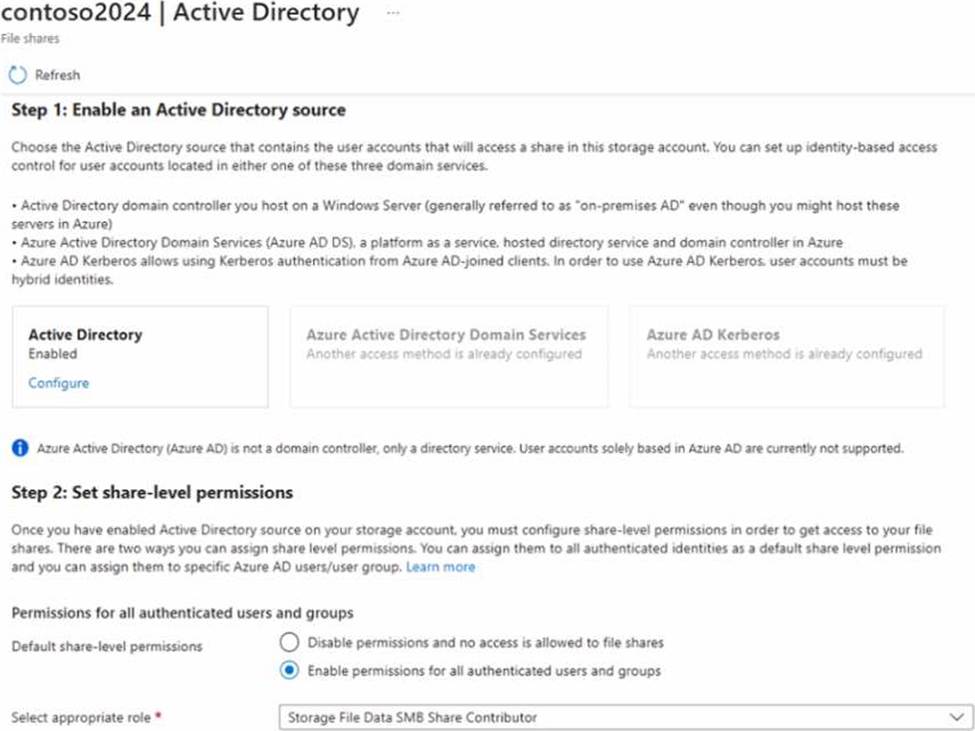
For each of the following statements, select Yes if the statement is true. Otherwise, select No. NOTE: Each correct selection is worth one point.

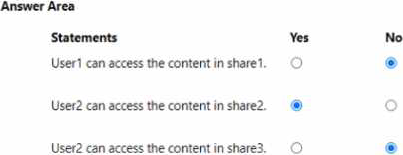
HOTSPOT
You have an Azure subscription named Sub1 that contains the blob containers shown in the following table.
Sub1 contains two users named User1 and User2. Both users are assigned the Reader role at the Sub1 scope.
You have a condition named Condition1 as shown in the following exhibit.
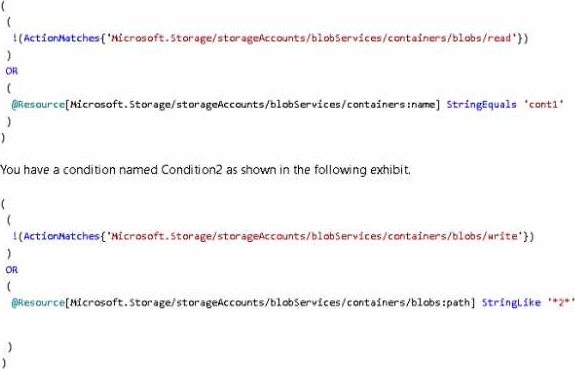
You assign roles to User1 and User2 as shown in the following table.

For each of the following statements, select Yes if the statement is true. Otherwise, select No. NOTE: Each correct selection is worth one point.
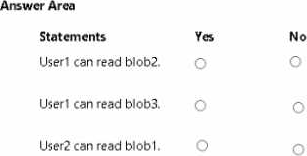
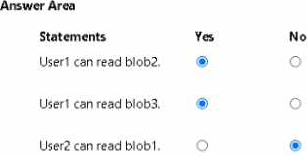
You have an Azure subscription that hat Traffic Analytics configured.
You deploy a new virtual machine named VM1 that has the following settings:
• Region- East US
• Virtual network: VNet1
• NIC network security group: NSG1
You need to monitor VM1 traffic by using Traffic Analytics.
Which settings should you configure?
- A . Diagnostic settings for VM1
- B . Insights for VM1
- C . NSG flow logs for NSG1
- D . Diagnostic settings for NSG1
C
Explanation:
Traffic Analytics analyzes the network security group (NSG) flow logs to provide insights into traffic flow in your Azure cloud1. NSG flow logs are a feature of Network Watcher that allows you to view information about ingress and egress IP traffic through an NSG2. To use Traffic Analytics, you need to enable NSG flow logs for the network security groups you want to monitor1.
Diagnostic settings for VM1 or NSG1 are not required for Traffic Analytics. Diagnostic settings are used to stream log data from an Azure resource to different destinations such as Log Analytics workspace, Event Hubs, or Storage account3. Insights for VM1 are also not required for Traffic Analytics. Insights are a feature of Azure Monitor that provide analysis of the performance and health of an Azure resource4.
You have an Azure subscription that contains a resource group named RG26.
RG26 is sot to the West Europe location and is used to create temporary resources for a project.
RG26 contains the resources shown in the following table.

SQLD01 is backed up to RGV1.
When the project is complete, you attempt to delete RG26 from the Azure portal. The deletion fails.
You need to delete RG26.
What should you do first?
- A . Stop the backup of SQLDB01.
- B . Delete sa001.
- C . Delete VM1.
- D . StopVM1.
A
Explanation:
You can’t delete a vault that contains backup data. So in this case at first you have to delete the backup of ‘SQLD01’ before you attempt to delete the vault.
Reference: https://docs.microsoft.com/en-us/azure/backup/backup-azure-delete-vault
HOTSPOT
You have three Azure subscriptions named Sub1, Sub2, and Sub3 that are linked to an Azure AD tenant.
The tenant contains a user named User1, a security group named Group1, and a management group named MG1. User1 is a member of Group1.
Sub1 and Sub2 are members of MG1. Sub1 contains a resource group named RG1. RG1 contains five Azure functions.
You create the following role assignments for MG1:
• Group1: Reader
• User1: User Access Administrator
You assign User1 the Virtual Machine Contributor role for Sub1 and Sub2.
You assign User1 the Contributor role for RG1.
For each of the following statements, select Yes if the statement is true. Otherwise, select No. NOTE: Each correct selection is worth one point.


Note: This question is part of a series of questions that present the same scenario. Each question in the series contains a unique solution that might meet the stated goals. Some question sets might have more than one correct solution, while others might not have a correct solution.
After you answer a question in this section, you will NOT be able to return to it. As a result, these questions will not appear in the review screen.
You have an Azure Storage account named storage1.
You need to enable a user named User1 to list and regenerate storage account keys for storage I.
Solution: You assign the Reader and Data Access role to User1.
Does this meet the goal?
- A . Yes
- B . No
